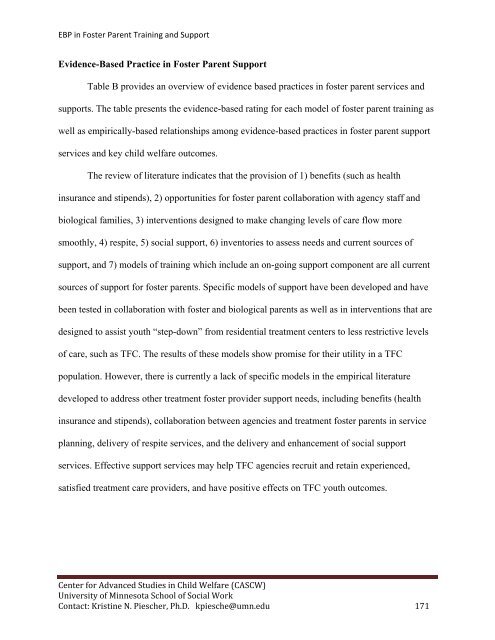Evidence-Based Practice in Foster Parent Training and Support ...
Evidence-Based Practice in Foster Parent Training and Support ...
Evidence-Based Practice in Foster Parent Training and Support ...
Create successful ePaper yourself
Turn your PDF publications into a flip-book with our unique Google optimized e-Paper software.
EBP <strong>in</strong> <strong>Foster</strong> <strong>Parent</strong> Tra<strong>in</strong><strong>in</strong>g <strong>and</strong> <strong>Support</strong><strong>Evidence</strong>-<strong>Based</strong> <strong>Practice</strong> <strong>in</strong> <strong>Foster</strong> <strong>Parent</strong> <strong>Support</strong>Table B provides an overview of evidence based practices <strong>in</strong> foster parent services <strong>and</strong>supports. The table presents the evidence-based rat<strong>in</strong>g for each model of foster parent tra<strong>in</strong><strong>in</strong>g aswell as empirically-based relationships among evidence-based practices <strong>in</strong> foster parent supportservices <strong>and</strong> key child welfare outcomes.The review of literature <strong>in</strong>dicates that the provision of 1) benefits (such as health<strong>in</strong>surance <strong>and</strong> stipends), 2) opportunities for foster parent collaboration with agency staff <strong>and</strong>biological families, 3) <strong>in</strong>terventions designed to make chang<strong>in</strong>g levels of care flow moresmoothly, 4) respite, 5) social support, 6) <strong>in</strong>ventories to assess needs <strong>and</strong> current sources ofsupport, <strong>and</strong> 7) models of tra<strong>in</strong><strong>in</strong>g which <strong>in</strong>clude an on-go<strong>in</strong>g support component are all currentsources of support for foster parents. Specific models of support have been developed <strong>and</strong> havebeen tested <strong>in</strong> collaboration with foster <strong>and</strong> biological parents as well as <strong>in</strong> <strong>in</strong>terventions that aredesigned to assist youth “step-down” from residential treatment centers to less restrictive levelsof care, such as TFC. The results of these models show promise for their utility <strong>in</strong> a TFCpopulation. However, there is currently a lack of specific models <strong>in</strong> the empirical literaturedeveloped to address other treatment foster provider support needs, <strong>in</strong>clud<strong>in</strong>g benefits (health<strong>in</strong>surance <strong>and</strong> stipends), collaboration between agencies <strong>and</strong> treatment foster parents <strong>in</strong> serviceplann<strong>in</strong>g, delivery of respite services, <strong>and</strong> the delivery <strong>and</strong> enhancement of social supportservices. Effective support services may help TFC agencies recruit <strong>and</strong> reta<strong>in</strong> experienced,satisfied treatment care providers, <strong>and</strong> have positive effects on TFC youth outcomes.Center for Advanced Studies <strong>in</strong> Child Welfare (CASCW)University of M<strong>in</strong>nesota School of Social WorkContact: Krist<strong>in</strong>e N. Piescher, Ph.D. kpiesche@umn.edu 171
















